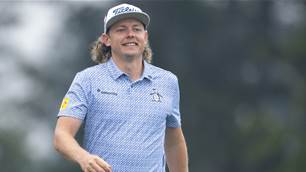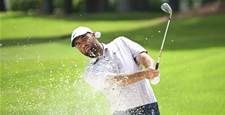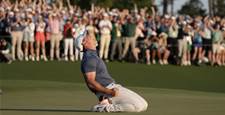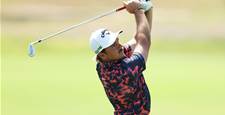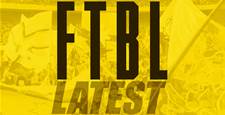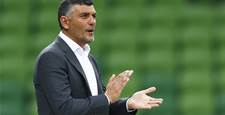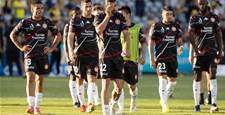Winning comp as captain all that's left for GI in NRL.
Greg Inglis has long stood out as the NRL’s foremost talent. But to earn acclaim as the game’s best, he’ll have to lead his team to that status as well.
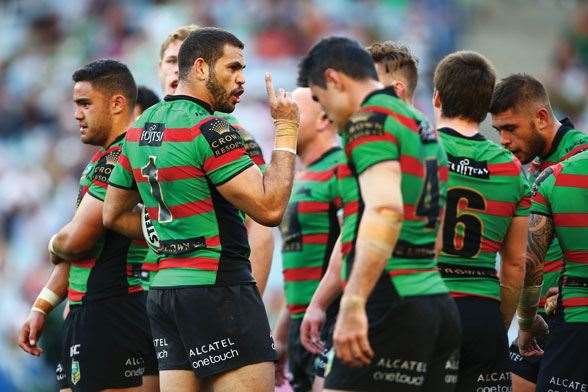 (Photo by Getty Images)
(Photo by Getty Images)Never let ’em see you sweat. Greg Inglis might believe that, or he might not. Famously, he gives so little away, to the point of coming across as enigmatic. He’s also known for being supremely confident; so confident, in fact, that he entirely dispenses with the usual play-acting sports stars put on to convince us of their confidence. In any case, whether he’s showing the effects of the NRL grind, or the pressure of football stardom, it is usually a non-issue. On the field, GI is the one who makes others break out in sweat, nervous, strained or otherwise.
On this afternoon, the South Sydney star is at the NSW Institute of Sport’s lab in Homebush, on duty for a sponsor, Powerade. The day’s focus is, quite literally, perspiration. A bunch of journos offer themselves up as guinea pigs for an exercise in how heat and humidity affects physical performance, which consists of stationary bike rides outside and then inside a climate-controlled room. Inglis grins at the suggestion that it’s like playing hot footy in far north Queensland; more likely, he’s glad that he doesn’t have to do it. He lolls about with an odd mixture of curiosity and diffidence. He checks out a power meter, works deliberately through a table full of paraphernalia he has to scrawl his signature on. He’s relaxed, in the way that footballers only can be when they don’t have another game bearing down on them. It hasn’t been this way for a while: no long finals campaign, no rep commitments to fill up this offseason. Inglis offers the usual regrets about an early finals exit, but concedes that he thoroughly enjoyed to the downtime. “Just getting away, enjoying my break.”
For the pedalling journalists, it’s rather chastening to be watched by perhaps the single best athlete going around in Australian sport at present. Any consideration of Inglis starts there – he is a physical marvel, blessed and built to do things other high-level athletes know are outside their capability. He embodies the common descriptions: freak, beast, machine. For a talent this exceptional, great feats would surely follow. Back in 2007, Inside Sport posed the question about the then-20-year-old who had just completed his second season for the Melbourne Storm: was Inglis the one? “There’s already hushed discussion that he’s beyond special,” observed the writer, Andrew Webster. “The question that hangs above the game is this: just who can he become? For his club? For his people? For himself? And the game?”
Inglis has won everything important to win in rugby league, both team and individual, no matter what revised record books might say. After becoming the best player at one position in his early years, his move to another has reshaped the way line-ups are constructed across the NRL. He has scored more tries than anyone else on his game’s – and perhaps all of Australian sport’s – most brightly-lit stage, in the process earning the eternal antipathy of a state that would change its opinion in a heartbeat had he decided to play for them. And while NSW collectively bears its grudge, the Souths fans among them can’t feel that way about one of the key players in bringing about the epochal end of a four-decade wander in the premiership wilderness, one of the more storied episodes in recent league history.
But for all of his career achievements, as for what can rightly be called a “legacy” without sounding overblown, perhaps one trumps them all: Inglis is the one who stayed. If this latest era in the NRL has been defined by who was missing as much as who was there, Inglis’ presence in the sport loomed as large as he does on the paddock. Sonny Bill, Burgess, Izzy, Hunt and Hayne – in that class of the NRL’s elite athletic talents, capable of porting to a whole other code or country, it was only GI that didn’t stray. There was the dalliance with the AFL and Essendon (a sliding doors moment if there ever was one), or a rumour of a lucrative offer from French rugby, but the fact remains that Inglis has enjoyed a rugby league career in full, to be placed in context alongside those of the greats.
Hayne mania had just had its Pacific-spanning moment, and the Rugby World Cup had been the global stage for the union converts, playing for three different nations. Asked whether he took an interest – nothing professional, just as a fan – in the goings-on of his peers, Inglis still wouldn’t be drawn. “I follow them because they’re my mates. But I’m not really looking sideways at the moment,” he says. “I admire what they’ve done, and for trying something new.”
Not looking sideways. What’s in front of him is plenty compelling. Even after a 2015 season in which he appeared physically limited at times, Inglis is one of the few players in the league who is not judged solely on his performance. The follow-up year after a premiership victory proved difficult, as those years often do. But at Inglis’ level, the judgment becomes comprehensive. Watching the North Queensland Cowboys exult after last season’s grand final, you understood that Johnathan Thurston had not only won a premiership, but grabbed the title belt as the league’s best player.
Few have the ability, or sometimes the right set of circumstances, to reach that lofty status. Implicit is a question: what does it mean to be the best player in the league? What does it amount to? In the NRL’s star-driven system, the balance between individual brilliance and the bottom line of winning is often misunderstood. For any would-be Immortal, it’s not enough just to play well, pile up stats or pull off highlight acts on the field. He has to bring his team along with him; his play has to give his team its character. It’s not enough for Inglis to be a powerful, versatile piece, gobbling up territory and opponents like a queen in chess – he’s got to control the board.
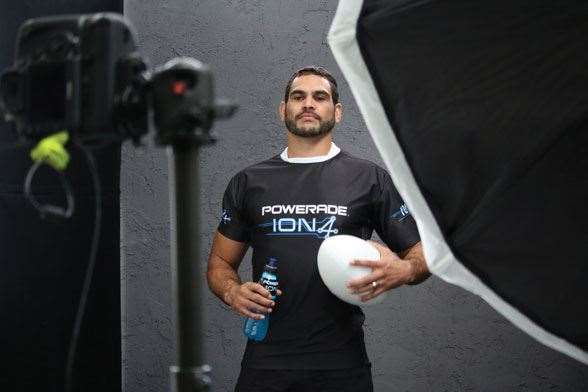 Greg Inglis, the face of more than South Sydney. (Photo courtesy Powerade).
Greg Inglis, the face of more than South Sydney. (Photo courtesy Powerade).Greg Inglis is definite about it: he was healthy enough to go last season. Even if he had to miss the last two rounds of the home-and-away because of knee surgery in late August, before returning for Souths’ loss in the first week of the finals. If he was on the field, he was right. “We have the right people in the right places that look at your performances, look at the data, what you do,” he says.
“It wasn’t like, ‘We need you to come on.’ It wasn’t anything like that. It was just one of those things where I felt fine. If an athlete comes up to you and you’re running fine, not showing any signs of weakness or injury, what choice do you have besides playing?”
The desultory end to the Rabbitohs’ 2015 blotted out everything that had come before it. Off the high of 2014, Souths started the next season like it hadn’t missed a step, with four wins from its first five matches including the blowout of Brisbane on opening day, a measuring-stick victory over the Roosters and the harsh Good Friday slugfest against Canterbury. Souths sat atop the table after that game, but attrition began to tell. Nevertheless, they travelled through the rep period neatly enough, and when they went on the road to Townsville and beat the eventual-champion Cowboys, the Rabbitohs had a win-loss record of 13-8, good for fourth, and not altogether far off their pace of 2014.
But the Bunnies went winless from there, beginning with a grudge rematch against the ’Dogs, which also saw Inglis limp off with ten minutes to go. Without him in the line-up, Souths crashed to a pair of losses by a combined 65 points. Inglis’ return for the qualifying final couldn’t change the momentum at that stage, as Cronulla raced to an 18-0 half-time lead and eliminated the defending champs 28-12.
“It’s a marathon season,” Inglis says. “Having a lot of injuries throughout the season, long-term injuries, too, chopping and changing of people. But the people that we had there, we had full trust in them to do the job. We showed full faith in whatever positions they’re in. End of the day, we didn’t perform the way we can, that South Sydney can perform. Obviously at the back end it just showed.”
It was an abrupt finish. In terms more familiar to Souths’ co-owner Russell Crowe, it wasn’t so much the wrong ending to the script had been written; it felt more like the script’s finals pages had been torn off. This wasn’t quite what had been envisioned for the Rabbitohs. Every premier gets its moment to bask, and Souths’ long-awaited victory did generate much ruddy goodwill. But the club was being hailed as more than that – a potential dynasty in the making, with seemingly all the necessary resources on hand: a historic brand, deep pockets to reach into and a core of young players that were still tracking an upward curve. And they also had GI.
Rugby league’s sentimental favourites no longer had cause for sentiment to be on their side. If anything, the club once kicked out of the comp had become fashionable. Every premier becomes a target, but the bullseye painted in myrtle and green stood out particularly. “When you win a title, everyone wants to step up and dethrone the reigning premiers,” Inglis says. “Everyone wants to knock you off your perch. That’s what’s happened this year, and we just have to reassess the season and go back and work.
“Of course, the club did [handle being a target]. The same beliefs were still there compared to last year. It was just, you can have the best preparation you can and lose a game, then have the worst preparation and win a game. It’s just a frame of mind and how you’re going to turn up on that day.”
Inglis’ frame of mind was tested by new responsibilities. He was named captain before last season, a long-foreseen decision. His coach Michael Maguire had viewed Inglis as officer material going back to their days with the Storm “though a lot of people wouldn’t have seen him in that light,” Maguire wrote in his recently published book about the 2014 season. “He was a shy young man and Melbourne already had plenty of acknowledged on-field leaders ... By the time he came to Souths in 2011, Greg had matured a lot, as a young man would naturally between the ages of 19 and 24, and he was ready for a leadership role.”
Although the progression seemed inevitable, the timing wasn’t fortunate. Incumbent John Sutton had been embroiled in a preseason brawl scandal in Arizona, and with those contract rumours ever-swirling, there was the notion going around that Inglis’ promotion was an attempt to bind him tighter to the club. He wasn’t going to wear captaincy lightly. “No doubt about it, it did take me away from my game a bit.
“But I reassessed, realigned myself, and I had good people around me who I chatted to about it. End of the day, I was appointed captain for a reason, and that’s because I play footy the way I do. And I went away from that for a little bit. There were challenges that came with it, and I just had to deal with it. Did I deal with it the best way possible? Probably not. Did I go away from the football that I’m capable of? Yeah, I did.
“It was just one of those things that happened. At the time I did notice it and I went back to what works for me.”
Unsurprisingly, he feels the best way for him to lead is to be GI. Lead by example, insofar as most players can’t exactly copy what he does. “Exactly. I think the most important thing in a leadership role is you’re in there as a leader for a reason. You know what works, you know how to get your boys around you to group together. That’s the most important thing. Like I said, I went away from it, picked myself up and went back at it. Cameron Smith never changes the way he plays. He just gets out there and keeps competing.”
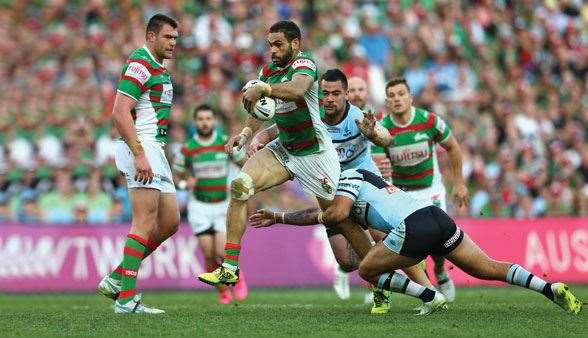 (Photo by Getty Images)
(Photo by Getty Images)Viewed from a different angle, the Queensland State of Origin side is not just the clockwork outfit that restored order last year and collected its ninth series win in ten years. It’s effectively an advanced class in rugby league leadership, with a club captain liable to be there in any direction you turn. It stands to reason that such a team knows how to lead itself, while not splintering apart with its multitude of strong personalities.
“You just got to turn up and be ready to play,” says Inglis, simplifying something that is probably much more complex in practice. “Mate, we just got one captain, that’s Cameron Smith. We all know that, recognise that. We sit down and have meetings, and talk about the games. That’s what you do as a team, you voice your opinions.”
Even as the Maroons were resuming normal service against NSW, there was a distinct sense that this was a bit of a clean-up for the veterans after seeing the streak come to an end: Justin Hodges was retiring, and coach Mal Meninga eventually would move on to the national job. Meanwhile, a new generation, with the likes of Daly Cherry-Evans and Michael Morgan, was on its way.
A couple of years younger than the Smith-Thurston-Hodges-Billy Slater-Corey Parker class, Inglis figures as a future Queensland leader. He finally had a chance to start in the no.1 jumper with Slater missing for Origin III, and the 52-6 scoreline reflected the logic of the move. He pushed his Origin try-scoring record to 17, and his form in the last two matches was a firm rebuke after a subdued game one, which he played coming off a hospital stay for a chest infection.
If Inglis is reluctant to talk about, well, a whole range of topics, the subject of the Queensland Origin side shuts him right down. It might be the hothouse atmosphere that surrounds the interstate contest, or the vitriol directed his way because he did grow up in Bowraville. He might just be sitting back and enjoying one of the great rides in league history. What does he think of the near future for the Maroons? “As far as I know, that’s not ... ” he laughs ruefully “ ... my department to be picking things. I’m just happy to be in the squad, keep playing rep footy for as long as I can.” And the Queensland captaincy? “If I get thrown the ‘c’ against my name in an Origin side, mate, that’s a bonus. But another bonus is being selected in the side.”
It’s undeniable, though, that the youthful hotshot, the Churchill Medallist at 20 years old, is now approaching 30 and a different place in his career. When Johnathan Thurston withdrew from the All-Stars Game, it naturally fell to Inglis to take upon the captain’s duty for the Indigenous side. Long held up as a potential role model in the Indigenous community, Inglis is growing into the status. He’s shown himself to be more comfortable making his mind known on particular issues, whether it be Indigenous health and employment, the booing of AFL star Adam Goodes or fatherhood, revealing late last year through social media that he had another son from a previous relationship.
If leadership is now expected from a mature Inglis, he’ll be held accountable for how his team fares. It is perhaps the final achievement, the last level of the game, for him to unlock: lead a premiership side in his own right. Do what Thurston did. Be the best kind of best player in the league.
The obstacles are daunting, beyond the usual. The preseason atmosphere around the Bunnies hasn’t been free of trouble, tinged by the bizarre spat between Crowe and rising young playmaker Luke Keary during a banter-filled bonding session. While the matter was quickly settled, it resonated because of the delicate personnel decisions that Souths will soon face: Keary is up for a new contract, as is halves partner Adam Reynolds, and for that matter, Inglis, who continues to be linked to a move to the Brisbane Broncos.
A major factor in determining the Rabbitohs’ fortunes this season will be the Inglis-Burgess axis. One of the evident themes of Maguire’s book was how the dynamic of the two stars drove the ’14 campaign – rather than the feud it was made out to be in some quarters, the intensity of one spurred the other on. Their on-field success buried any notion of tension between them that year, but the moves made to accommodate big Sam’s return – forcing out the likes of Dylan Walker and Chris McQueen – has once again caused ripples around the club. While the Englishman’s star power is something a rugby league team wouldn’t refuse, he re-joins a side that appears a little less deep, and not as formidable, than the last few seasons.
Souths has become a test case familiar to any Supercoach devotee: spend your money on the top stars versus spreading it out.
Canterbury’s James Graham spoke to the basic-yet-compelling logic of the arrangement, telling The Australian: “You got GI rested and saying he is feeling as fit and fresh as he ever has and now with Sammy coming – you are talking about two of the best three or four players in the entire competition back together in the one team.”
Should the wins keep rolling in, there’s a better chance that harmony will prevail at Redfern. But the forecasts of dynasty made in late 2014 don’t look so certain now, and the decisions made in the front office – with Shane Richardson making a notable return from NRL headquarters to take over as manager of football operations – will have a profound effect on whether it can be realised, or if the next few years will instead see a rebuild.
The Rabbitohs’ on-field leader is clear-eyed about what can be achieved.
“Winning a premiership means everything,” Inglis says. “You spend so many hours with these guys that you train with. To go out there as a team and lift that trophy up, it’s very rewarding.” He understands how much it takes to get himself, and the rest of his team, there. It’s no small challenge, but he’s not sweating it.
Related Articles
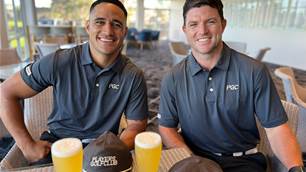
19 Holes With ... Chad Townsend and Val Holmes

Viva Las Vegas: Join Golf Australia magazine's Matt Cleary on a golf and rugby league spectacular
